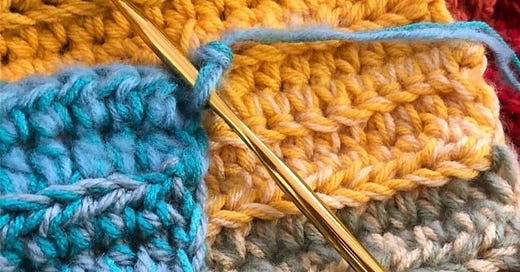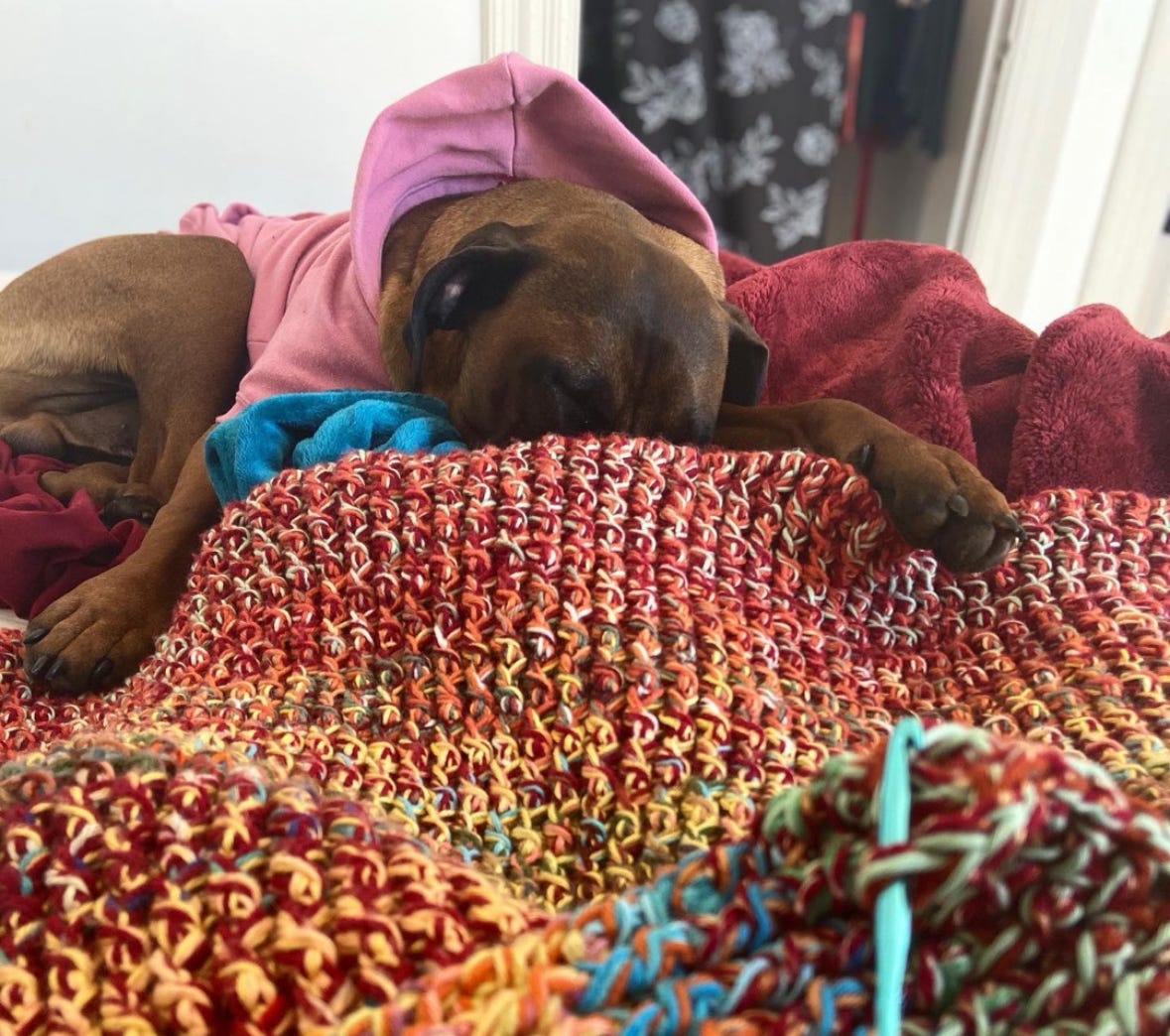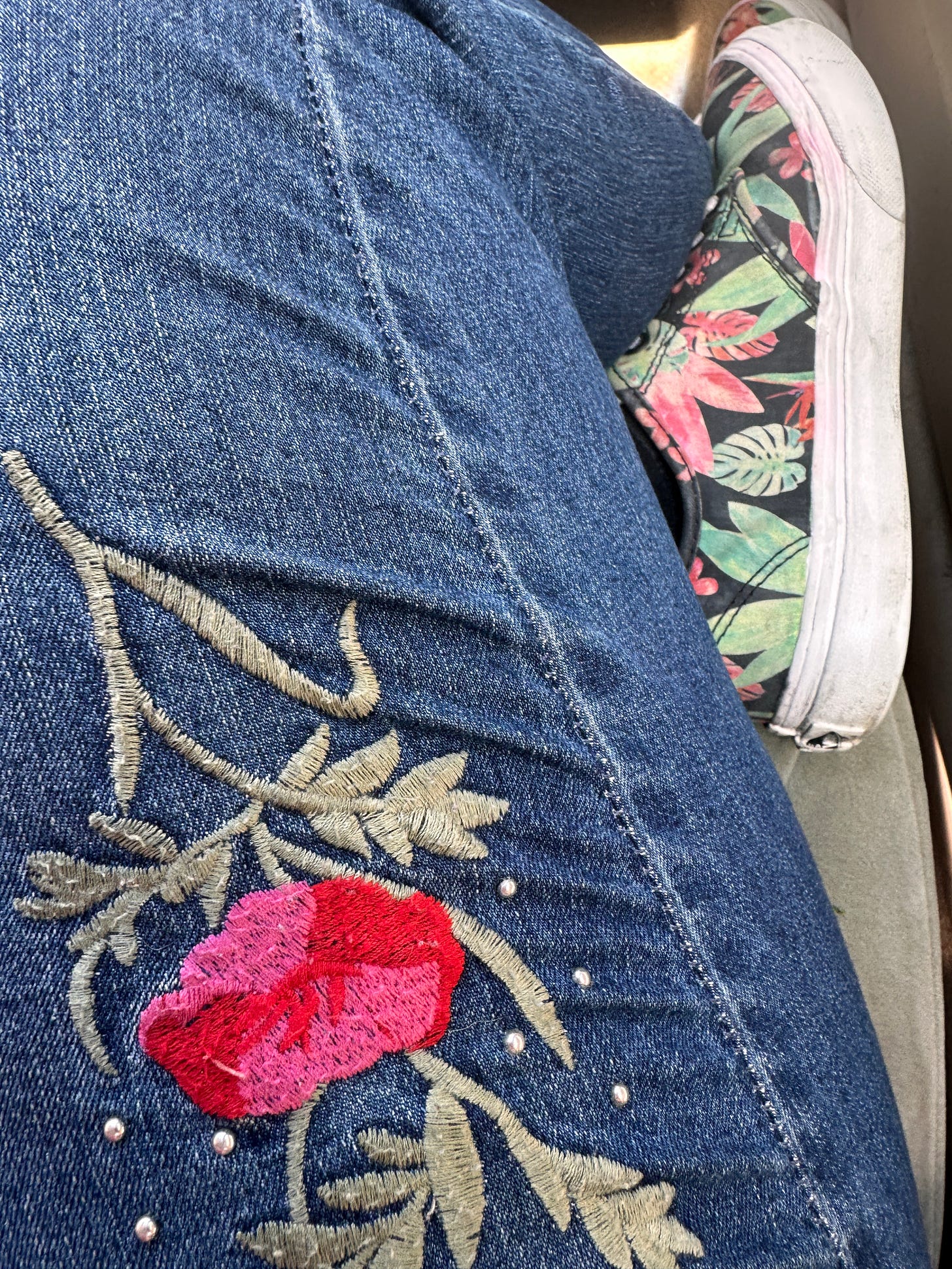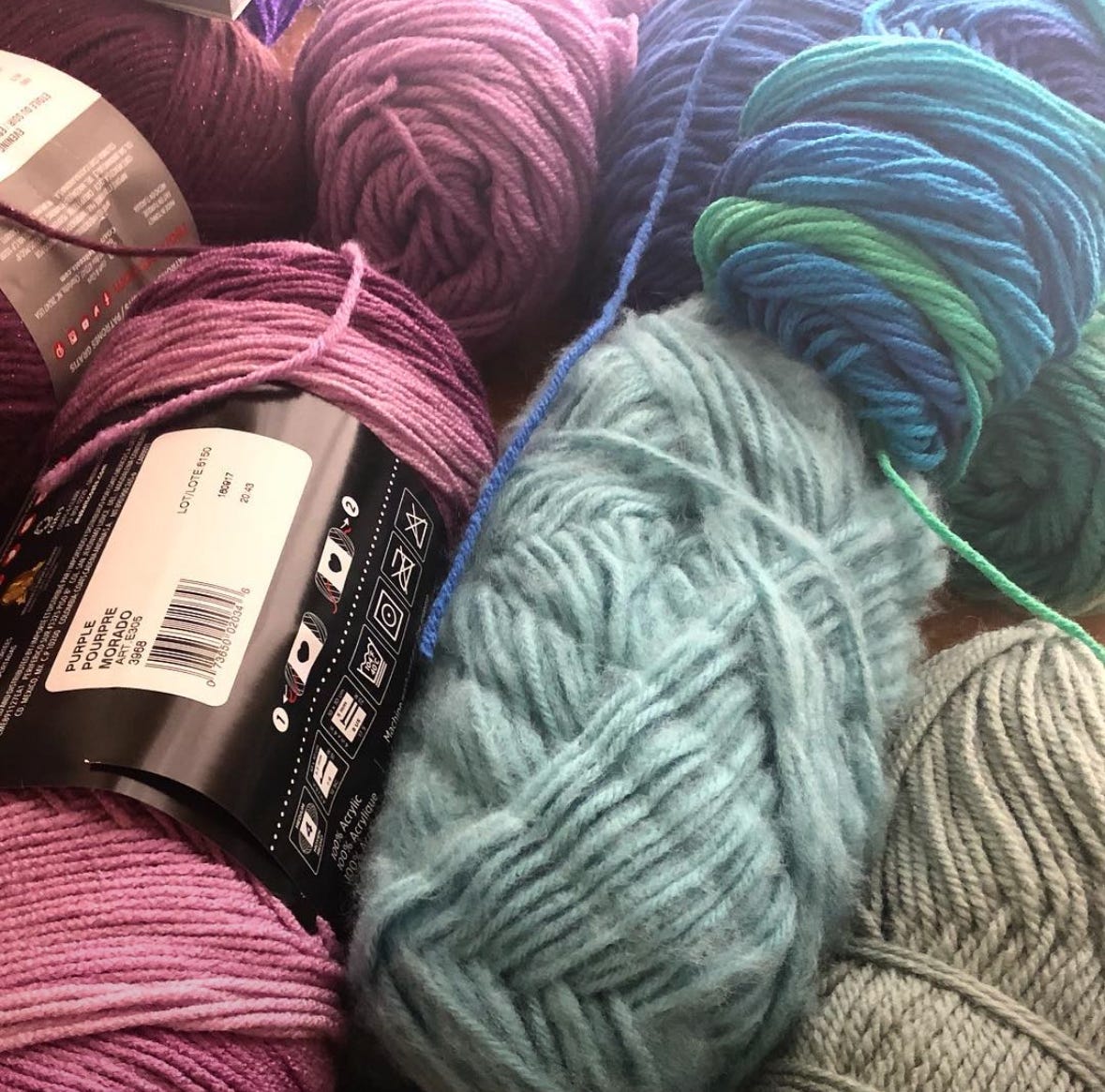Hands-On Activities as Preventive Self-Care for Total Wellbeing
"By taking just half an hour at some point during the day to meditatively stitch something for myself or someone else I bring my mind and heart back to a place of peace."
This is a series of related articles that originally appeared on the PsychCentral blog Crafting to Heal which I wrote in 2018-19 about craft as a form of preventative healthcare.
Reducing Depression with Hands-On Activities
I always hated it when I was in the midst of depression and someone would say to me, “just do something to take your mind off of it”.
If I had that much control over the chaos inside of my mind then I wouldn’t be stuck in my bed, doubled over by the pain of life, now would I?
So, of course, I hate to admit that those people were right. But in the end it proved to be true; getting outside of myself and immersed in a hobby eventually did become a big part of reducing depression’s grip on me.
What I found is that a hands-on activity that I could do alone, in my bed if need be, provided a number of mental health benefits and a much-needed break for my mind. I later discovered plenty of research to suggest that I was not alone in experiencing the therapeutic benefits of crafts and hobbies.
How Crochet Saved My Life
The craft that I discovered that resonated for me was the craft of crochet, the single-hook cousin to the two-needle activity of knitting. Adrift in the sea of depression, I was trying every single piece of advice I came across for getting better and one of those things was to go back to something that you enjoyed doing as a child. I’d made friendship bracelets and other things with yarn when I was younger so that’s what caused me to pick up crochet.
Truth be told, I did not think that this was going to do any good. It had been a long time since any activity at all had captured my interest. I truly believed that I would never be interested in anything ever again. My thoughts constantly turned to the option of suicide, not because I wanted to die but because I really did not want to have to keep on waking up to this painfully muted existence. I tried crochet because I had to try something, not because I believed in it.
There was no immediate miracle. It’s not as though I picked up a hobby and suddenly started whistling tunes and seeing the point to everyday life. But there was an occasional flicker of momentary relief. During this time of my life I was crying for hours every day, for no apparent reason, and although my yarn was often wet with salty depression there were also whole minutes of time when I would be so focused on pulling one loop up on to another that I would cease crying. My breathing would slow to a normal pace. My head would stop whirling with anxiety for a brief time.
It happened slowly, through a minute here and a minute there, of reprieve. Depression is so constant. Those minutes provided my brain with important rest and rejuvenation. It started to heal. I was soothed. I was buoyed. I was improved. Slowly and steadily, my daily quality of life was enhanced. Each day, I could practice my new craft. I could learn a new skill, create something out of nothing, get a boost of much-needed self-esteem. I could get better, one loop of yarn at a time.
7 Therapeutic Benefits of Crafting
Crochet was the craft that helped me but the benefits of the craft can be applied to many other hobbies and activities. Some of the main therapeutic benefits of a hands-on hobby include:
Breaking the cycle of rumination. Depression is a constant monologue of madness; a hobby provides an external focus to quiet that sound.
Mindfulness practice. You can learn to “be here now” when you are engaged in a hands-on task that requires some attention.
Repetitive activities release serotonin. Whether it’s crochet or whittling, an activity of repetitive action serves as a natural anti-depressant.
It becomes a talking point to be proud of. I was so relieved to finally have something to say to my friends and family about what I was doing instead of just talking about my misery. They might not crochet but they were happy to hear me talking about something new!
Creating something by hand is a skill. Learning something new and having a product to show for it improves self-esteem and our sense of our own value.
Hobbies connect us to others. You can talk (online or in person) to other enthusiasts, make your craft to donate to charity and celebrate being part of a niche in history.
Practice problem-solving. We start small by solving problems in our craft and it reminds us that we can solve the bigger problems in life. We learn to imagine better outcomes.
5 Unique Benefits of Yarn Crafts
Yarn crafts heal us in so many different ways.
I love finding different articles that explore this topic. Sometimes they are academic or research-based. More often, though, they are anecdotal.
The stories people share about their own experience of the benefits of yarn crafts always teach me something.
For example, my thoughts perked up when I saw this article by Stephanie Kuehnert of the Forest Park Review that touches on this topic. Kuehnert wrote about a yarn store that celebrates the contemplative benefits of the craft.
Kuehnert’s Benefits of Yarn Crafts
Kuehnert’s article is about her experience knitting in a particular yarn store. She identified five unique benefits of yarn crafts from her own experience.
1. Yarn crafts help you pace your drinking.
This is great if you get together for crafts and cocktails with your friends. With busy hands you imbibe less, taking in fewer calories and reducing the likelihood of drunkenness while still enjoying your girls’ night.
Although she doesn’t mention it, one of the benefits of yarn crafts is that crafting can be a replacement for drinking altogether. People with social anxiety, or those who simply get stressed meeting new people, benefit from having a focused activity when they’re in a group. Crafting together is a great activity.
2. Crafting gives you something to do while watching TV.
This one isn’t a new idea to me. In fact, when I was dealing with my own depression I used to just sit there and watch hours upon hours of crime drama TV shows. This increased my anxiety and made me feel like the laziest, least productive person in the world. At least if I was crocheting while I watched TV then I felt productive despite the long hours in front of the screen.
3. The ability to “relax while feeling creative and productive at the same time”.
Relaxation is a really important part of our every day lives. It is healthy to take time to be still and quiet, to give both mind and body some time to rest in our waking lives. So often we want to stay busy and be creative and productive; crochet lets us achieve that while simultaneously resting, which is an amazing paradox.
4. Yarn crafts offer a break from workaholism.
Kuehnert mentions that she’s prone to working too much. Crafting is something she can do to actively get away from constant work. I understand this one because as a self-employed individual I’m prone to overworking as well. Often I will turn to crochet as something that isn’t work but fuels my work in a way.
5. It is a zen solution to almost all of life’s problems.
There are many things in this lifetime that you have no control over. You have control over your hook and yarn. Sometimes immersing yourself into creating with yarn is all that you can do – and surprisingly, it is often enough! Of all of the points that the author made in her article, this is the one that she was really trying to drive home.
The Knit Nirvana Store
Kuehnert was inspired to write about her experience with yarn crafting in an article about a specific yarn store called Knit Nirvana. This Illinois-based yarn store is co-operated by two women who bring decades of knitting and crochet experience to the table. The store sounds lovely with its promise of:
“We strive to inspire and teach you to enjoy both your finished handmade object and the entire crafting experience.
We hope to impart the bliss of knitting and crocheting within a relaxed, friendly and fun environment; to enable you to create artistic, singular garments and objects.”
I love the idea of crafting being a path to bliss!
5 Hands-On Activities to Try
Crochet is the hobby that worked for me but any hands-on activity that you can get started with fairly easily can have therapeutic benefits. Here are five activities to try to get started:
1. Building model cars or planes. A male friend of mine who read my book, Crochet Saved My Life, told me that the benefits of the mindfulness that I describe are the same things he experiences when he is immersed in building model cars.
2. Appliance hacking. In his book Made By Hand: Searching for Meaning in a Throwaway World, author Mark Frauenfelder discusses the immense satisfaction of hacking an espresso machine to see how it works and how to make it work better.
3. Gardening. Literally getting your hands dirty can make you feel more connected to the earth and more connected to yourself as a result.
4. Working with wood. Whether you’re whittling yourself a statue or building large pieces of furniture this focused, creative task serves as a place for your imagination to thrive again.
5. Knitting or crochet. Many men have found needlework to be surprisingly relaxing. In fact, there are crochet programs in prisons across the nations designed to help male inmates give back to the community while healing themselves in what is normally a destructive environment.
If you don’t find yourself immediately drawn to an activity, relax; there is something out there that you will enjoy so keep on trying! Try to think back to the activities you liked as a child and go back to those basics. Clay, building blocks, drawing, digging holes, doing science experiments … these are all starting points for finding your way out of depression.
Craft as Part of a Well-Rounded Treatment Plan
Crochet was a crucial part of helping me to get through the chronic depression that had followed me around for fifteen years.
However, it would not have saved me alone.
For me, it was combined with therapy, medication, yoga, and strengthening my support system.
What works for each individual is different but craft can be one component of the treatment plan for people from all walks of life.
Consider that as you cobble together the bits and pieces of what ultimately works for you!
Craft as Self-Care: Crochet Each Day Keeps the Doctor Away
Crochet is a form of self-care for me. It helps me prevent, minimize, and/or manage the symptoms of depression.
Poem: The Difference
Every summer when I was growing up we would go to visit my grandmother, the only truly religious woman in our family. She had a poem by Grace L. Naessens hanging in her bathroom called The Difference, which is about the need to pray every day.
The poem describes someone who felt like life was so busy that there was no time to pray. However, then they realized that if you don’t take the time to pray, then life is way too overwhelming and feels even busier. Of all of the small religious things that could have stuck in my mind from those Ohio summers, it was this poem that stayed with me.
I personally don’t pray in the traditional way. Nevertheless, I understand the sentiment behind the poem. I feel like the gist of it applies to the reason that I crochet every day.
Crochet Every Day as Self-Care
I crochet even when (especially when) life feels so busy that it seems like there is no time to crochet.
The thing that you need to know about me is that crochet saved my life. I have had lifelong depression and went through a period of serious crisis, during which I was diagnosed with double depression.
I didn’t want to wake up in the morning. I could often barely get out of bed. I felt unproductive, uncreative and entirely hopeless. It was a dark time. I got through that time thanks to a good therapist, a light anti-depressant, a strong will and a lot of crochet.
Later, when I was ready to write a book about my experience, I met many other women who also shared their stories with me about how the benefits of crafting helped them to get through the most difficult times in their lives.
How Crochet Helps Us
Here are some of the benefits of crochet:
Crochet is a repetitive task, with a fluid motion that is highly soothing. This helps with relaxation. It encourages de-stressing. It reduces anxiety. It likely releases serotonin in the brain, a natural pain reliever and natural anti-depressant.
Crafting brings you back to the present moment. You stop worrying about the future and trying in vain to fix the past and just be where you are, which is a very mentally healthy space to be.
Crochet is an easy way to make something for someone else. It makes you feel like you are productive and can be a tool towards generosity and this boosts self-esteem.
Crochet is easy. Life can feel really hard and difficult and “too much” sometimes. When it does, I crochet, because it is something I can accomplish and this reminds me that I can handle and accomplish other things in life as well.
Crochet Prevents Depression Relapse
I am thrilled that I survived my depression and am doing well now. Nevertheless, this was a condition I struggled with for more than a decade and I know that I am always at risk of sliding backwards in my own mental health journey. I must do all that I can to stay healthy each day. Therefore, I continue to crochet as a regular part of my wellness plan.
By taking just half an hour at some point during the day to meditatively stitch something for myself or someone else I bring my mind and heart back to a place of peace.
I express myself, I calm myself, I become and remain a stronger and saner and healthier person.
What happens on days when I am “too busy” to crochet? One of the lines in Naessens’ poem is: “Problems just tumbled about me and grew heavier with each task” … that is how I feel if I get so busy with all of the so-called important activities in life that I can’t take a little bit of time out for myself to craft.
Without a bit of time to crochet I rush, I hurry, I fret. Without that moment of peace I can’t get perspective on things and problems seem bigger than they need to be. When I don’t crochet, life starts to feel too hard.
What Is Your Daily Self-Care?
I do not think that you need to be “sick” to need to take time out of your very busy life each day to take care of yourself. A human body and mind and soul need taking care of. (Besides, I think we’re all existing on a mental health spectrum anyway. We all have mental health.)
I believe that we cannot be our best, most productive, most creative selves if we do not put nurturing ourselves at the top of our To Do lists. I believe that there is no way we can be successful caregivers to the others in our lives if we do not first take care of ourselves. For me self-care includes crochet every day … what does it mean for you?
If you read this far, perhaps you liked the work. The work does take work. It only continues with support, so please consider subscribing. My annual rate starts at $10 per year.













I'm so glad you found crocheting when you needed it most! For me, knitting helps with occasional anxiety; I can see how it helped you with depression. Your story touched me.
I also tend to knit (sometimes crochet) while watching tv; I agree it makes you feel like you are doing something constructive rather than just sitting there.
Thank you for sharing your experience. :)
A lovely article. I do many crafts but find the ones that I like best end with a practical gift. You make something for someone that will (hopefully) make them happy, while the making of it makes you happy. All for the price of one thing.
I found that if I was sewing or doing crochet I would absorb information better. Though I never managed to convince my bosses that by doing embroidery in a training session, I would be more receptive to the information being shared!